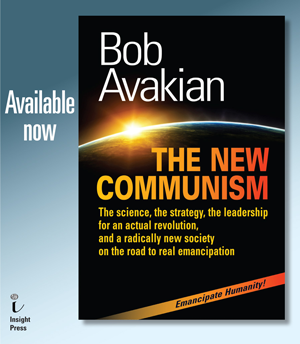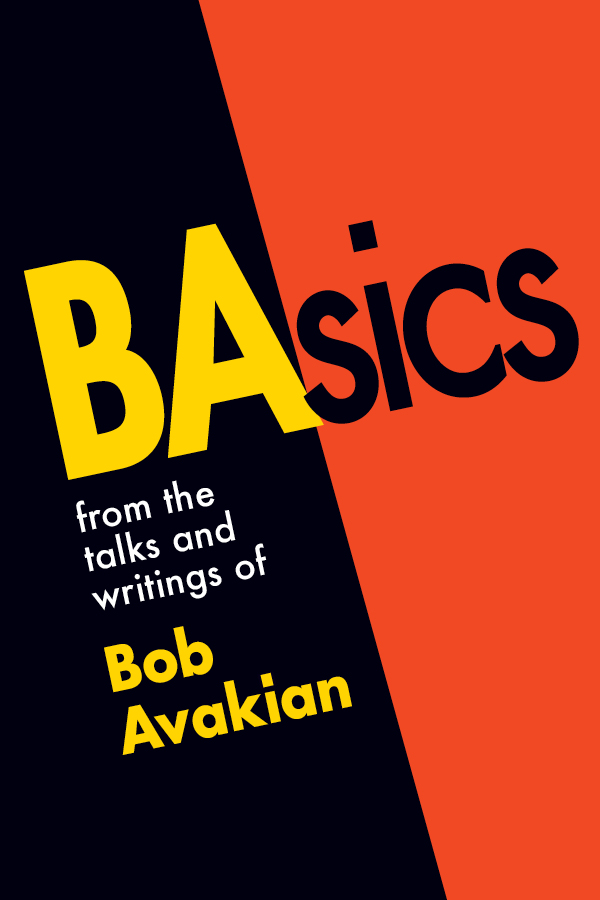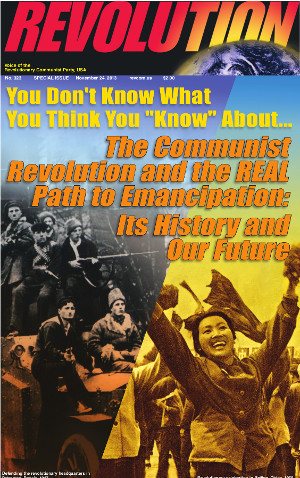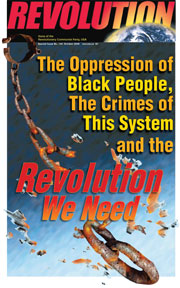THE SCIENCE, THE STRATEGY, THE LEADERSHIP
FOR AN ACTUAL REVOLUTION,
AND A RADICALLY NEW SOCIETY
ON THE ROAD TO REAL EMANCIPATION
FRAMEWORK AND GUIDELINES FOR STUDY
AND DISCUSSION
March 23, 2016 | Revolution Newspaper | revcom.us
The presentation by Bob Avakian—THE SCIENCE, THE STRATEGY, THE LEADERSHIP FOR AN ACTUAL REVOLUTION, AND A RADICALLY NEW SOCIETY ON THE ROAD TO REAL EMANCIPATION—is a sweeping, comprehensive document of world-historic importance. At the same time as it has great immediate relevance, it also provides, in an overall and ongoing way, a foundation and strategic orientation in relation to the basic questions of human emancipation it speaks to, which are indicated and concentrated in the title. In order to facilitate the kind of serious and deep engagement with which this document should be approached—both the particular parts of this presentation and the decisive questions they address and, most fundamentally, the method and approach that underlies and runs through the presentation overall—the following provides a framework and guidelines for both individual study and collective discussion of this document.
Introduction and Orientation
* Why does this presentation begin by emphasizing the question: “for whom and for what?” Why, at the same time, does it emphasize the importance of theory and method?
* In BA’s opening presentation in the Dialogue with Cornel West, there is a section that speaks to “what if” the world could be radically different (and gets into a number of particular “what if’s”).
What is the reason and purpose for including this in that presentation—what role and aim does this have there? And how have you—and, as far as you are aware, how have others—understood and approached this?
* If what Lenin argues is true—about people being the foolish victims of deceit and self-deceit in politics, etc.—why is this true? And what is the importance of this, in relation to the transformation of society, and the ending of all exploitation and oppression?
I. Method and Approach, Communism as a Science
* Why is method and approach the most fundamental and essential thing in the new synthesis of communism?
* Why is it correct that “Everything that is actually true is good for the proletariat, all truths can help us get to communism”?
** Why is “class truth” wrong?
** Why is it the case that, in the relation between being partisan and being scientific, being scientific is principal?
* BAsics 4:10 argues that relativism—and treating truth as subjective, and a matter of “narrative,” rather than correspondence to objective reality as the criterion of truth—will ultimately contribute to remaining trapped within a world where “might makes right.” Is this true, and if so why? And what does this question of epistemology have to do with getting beyond such a world?
* What is the difference between materialism—dialectical materialism—and determinism (or “determinist realism”)?
* In an episode of the TV show The Good Wife there is a scientist who makes the statement that human beings are just clusters of atoms, like everything else in nature. What is correct—and what is incorrect—about that statement? How can it be determined whether what is correct, or incorrect, about this statement is the main thing—the principal aspect?
* How should the following statement by Raymond Lotta, cited in the Presentation, be understood: “The basic change wrought by bourgeois society is the socialization of production.” How does this relate to the fact that capitalism represents and embodies the generalization of commodity production and exchange—and the key and pivotal role of labor power (the ability to work) as a commodity under capitalism?
* Why is it that “through which mode of production?” is the most important question in how any social problem is addressed? What is the relation between this and the understanding that this system cannot be reformed, but must be swept away?
* What difference does it make whether the driving force of anarchy (the contradiction between anarchy and organization in capitalist production and accumulation) or the class struggle between the bourgeoisie and the proletariat is the more important expression of the fundamental contradiction of capitalism?
* Is “solid core with a lot of elasticity on the basis of the solid core” just a policy—or is it something more, and if so what?
* Which is principal—which is the main and most decisive aspect—in the relation between epistemology and morality?
II. Socialism and the Advance to Communism:
A Radically Different Way the World Could Be,
A Road to Real Emancipation
* The “4 Alls”
** Why is the goal of the communist revolution not “equality”? What does getting beyond democracy and beyond equality have to do with Marx’s statement that Right can never be higher than the economic structure of society, and the culture conditioned thereby, and with getting beyond the narrow horizon of bourgeois right?
** What is the materialism, and the dialectics, of the “4 Alls,” and how should the interrelation of these “4 Alls” be understood?
** Marx begins the statement on the “4 Alls” by talking about how the dictatorship of the proletariat is the transition to the achievement of these “4 Alls.” Why is the dictatorship of the proletariat necessary for this?
* BAsics 2:12
** Why is what is said in BAsics 2:12 correct, and what is its importance? How is this different from how this has been widely understood in the international communist movement?
** What does BAsics 2:12 have to do with why it is that, while socialism is three things—a radically different economic system; a radically different political system; and a transition to communism—a socialist state must be, above all, a base area for the world revolution?
* What is the relation between meeting the needs of the people in socialist society—broadly understood as meaning cultural as well as material needs—carrying forward further the transformation of economic and social relations, and the political and ideological superstructure, and supporting the world revolution? How, in turn, is this connected to the relation between abundance and revolution in the advance to a communist world?
* The Constitution for the New Socialist Republic in North America
** How is this Constitution an application of solid core with a lot of elasticity on the basis of the solid core? What does the “parachute point” have to do with this?
** Why is there provision for a military draft in this Constitution? And why is there inclusion of measures that may be taken in an emergency situation, which restrict the rights of the people? What does this have to do with the relation between necessity and freedom, and the principle that Right can never be higher than the economic structure of society, and the culture conditioned thereby?
* “Emancipators of Humanity”
** What does it mean that there is a great deal concentrated in the call to be “emancipators of humanity”?
** What is the relation between materialism and morality in this formulation: “emancipators of humanity”?
III. The Strategic Approach to An Actual Revolution
* Why, and in what way, is it correct to speak of strategically “working back” from “On the Possibility of Revolution” and that there is one overall strategic approach for revolution, with distinct but interrelated stages?
* How should the relation between “hastening” and “awaiting” a revolutionary situation be understood and applied?
* Discuss the content of “Some Principles for Building a Movement for Revolution” and the questions posed in the Presentation about this and “On the Strategy for Revolution.”
* Speak to the question posed in the Presentation about the dialectical relations involved in “Fight the Power, and Transform the People, for Revolution.”
* The United Front under the Leadership of the Proletariat (UFuLP) strategy
** Why is this the correct and necessary strategic orientation for revolution?
** What is the meaning and importance of the separation of the communist movement from the labor movement, and what is the relevance of this for revolution in this country?
** What is the importance of the “two maximizings”?
** It has been said that there can be no revolution without a powerful student movement with a strong current favorable to revolution and communism within that student movement. Why is that true?
** Why is it important for a section of the intelligentsia—understanding this to mean people in the arts, as well as in academia, and others—to be won to this revolution?
** Discuss the point in the Presentation about the relation between the importance of waging struggle against lines, programs, tendencies, etc., that are representative of the petite bourgeoisie, and maintaining and applying the strategic orientation of UFuLP.
** Why is the oppression of Black people an “Achilles heel” for this system in this country?
** Why is what is said in BAsics 3:22, about the emancipation of women and its relation to the communist revolution, correct, and why is it correct to say that, in today's world more than ever, the woman question—the struggle for the emancipation of women and the relation of this to the communist revolution—is more pronounced and more important than ever?
* Internationalism and This Revolution
** What is the importance of “revolutionary defeatism,” particularly in a country like the U.S.? To what degree is this orientation understood and taken up by people opposing the crimes committed by U.S. imperialism—and, more particularly, how well is this understood and applied as a matter of basic orientation, in terms of people in and around the Party and the movement for revolution?
** Discuss what is said in the Presentation about how revolution in (what is now) the U.S. not only needs to be internationalist in its fundamental orientation but also may have a significant aspect of being international.
** How does bringing about revolution here relate to “bringing forward another way” in key parts of the world, and the world as a whole?
* The promotion and popularization of the new synthesis of communism and the leadership of BA
** Why is this promotion and popularization, as concentrated now in the BA Everywhere campaign, a crucial part—one of the two mainstays and the leading edge—of building the movement for revolution and the Party as its leading core? How should the accusation of “cult” be understood and answered in relation to this?
** In the Interview with Ardea Skybreak, the title is Science and Revolution—On the Importance of Science and the Application of Science to Society, the New Synthesis of Communism and the Leadership of Bob Avakian. To what does “On the Importance” apply in that title?
* Discuss what is said—including the questions posed—in the Presentation about the role of the website/newspaper, as the second mainstay of the Party’s overall and ongoing work.
* Why is popularizing the strategy an important part of carrying out this strategy?
IV. The Leadership We Need
* If “the masses make history,” why is it true that leadership is decisive in order for the masses, and humanity as a whole, to be emancipated?
* Why should people join the RCP if it has been necessary, and is still necessary, to carry out a Cultural Revolution within the RCP to keep it on the road of revolution and communism?
* Discuss what is said, including the questions posed, in the Presentation—drawing from the Interview with Ardea Skybreak—about the fundamentally antagonistic relation between what is represented by this Party, and its leadership, in particular BA, and the ruling class.
* What is the importance of having a Party in this country based on the new synthesis of communism and the leadership of BA? What particular internationalist responsibilities does this place on this Party, and generally those upholding and applying this new synthesis?
* The “Ohio”
** How should this be understood and applied in building the movement for revolution and the Party as its leading core?
** What is the role and importance of the Revolution Clubs in relation to this “Ohio” (as well as more generally)?
* “Strategic commanders of the revolution”
** What is the meaning and importance of this formulation? Does this apply only to the leadership of the Party, or more broadly?
** How does the discussion in the Presentation on methods of leadership, and in particular the science and the “art” of leadership—and the relation between the two—relate to being “strategic commanders of the revolution"?
Conclusion
* What is most fundamental and pivotal in this Presentation?
* What is the relation between the basic orientation of “for whom and for what?” and the role of a consistently scientific method and approach, overall and specifically in relation to human society and its revolutionary transformation toward the goal of a communist world without exploitation and oppression?
Volunteers Needed... for revcom.us and Revolution
If you like this article, subscribe, donate to and sustain Revolution newspaper.








